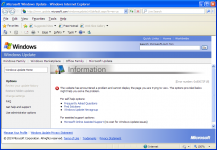gslick
Veteran Member
What is the current status of Windows Update for Windows XP? Is it completely dead now?
I have some systems that need to run Windows XP. I have system restore CD-ROMs/DVDs that will restore activated Windows XP SP2 Ghost images to the hard drive. In the past I have I installed the SP3 update and .NET frameworks through 4.0 (necessary for the intended specific use of these systems) after restoring the system image and then let them churn several hours or overnight on Windows Update to get all of the final Windows XP updates installed.
I realize that support for Windows XP back ended in 2014 and with the exception of KB4500331 on 5/9/2019 for the Remote Desktop bug there haven't been Windows XP updates for a while (ignoring Windows XP Embedded), but it still seemed like a good idea to get all of the updates that were available installed.
I just went through restoring the XP SP2 system image and then SP3 on one of these systems and can't get Windows Update to work at all after trying a few things and a few hours on it.
I vaguely remember updating from the original Windows XP IE 6 being necessary at some point to get Windows Update to work. Installing IE 8 didn't help. I also vaguely remember the Windows Update Agent being updated early in the set of updates that got installed and after looking around online I found references to the windowsupdateagent30-x86.exe update. Things changed after installing that, but still didn't work.
If Windows Update for Windows XP is completely dead now then at least I'll know not to waste any more time trying.
Updates can still be manually downloaded from https://www.catalog.update.microsoft.com/ but there are hundreds of them for Windows XP SP3. I looked at the update history of one of these systems that was up to date with updates the last time I went through the system restore and update process two years ago and it had close to 300 updates installed. It would be a huge amount of work to manually download and install all of those updates, or try to figure out which ones were most important to install.
Maybe at this point I should just leave the current system at its system restore image plus the SP3 update and never connect it to the network, or only on a completely isolated network.
I have some systems that need to run Windows XP. I have system restore CD-ROMs/DVDs that will restore activated Windows XP SP2 Ghost images to the hard drive. In the past I have I installed the SP3 update and .NET frameworks through 4.0 (necessary for the intended specific use of these systems) after restoring the system image and then let them churn several hours or overnight on Windows Update to get all of the final Windows XP updates installed.
I realize that support for Windows XP back ended in 2014 and with the exception of KB4500331 on 5/9/2019 for the Remote Desktop bug there haven't been Windows XP updates for a while (ignoring Windows XP Embedded), but it still seemed like a good idea to get all of the updates that were available installed.
I just went through restoring the XP SP2 system image and then SP3 on one of these systems and can't get Windows Update to work at all after trying a few things and a few hours on it.
I vaguely remember updating from the original Windows XP IE 6 being necessary at some point to get Windows Update to work. Installing IE 8 didn't help. I also vaguely remember the Windows Update Agent being updated early in the set of updates that got installed and after looking around online I found references to the windowsupdateagent30-x86.exe update. Things changed after installing that, but still didn't work.
If Windows Update for Windows XP is completely dead now then at least I'll know not to waste any more time trying.
Updates can still be manually downloaded from https://www.catalog.update.microsoft.com/ but there are hundreds of them for Windows XP SP3. I looked at the update history of one of these systems that was up to date with updates the last time I went through the system restore and update process two years ago and it had close to 300 updates installed. It would be a huge amount of work to manually download and install all of those updates, or try to figure out which ones were most important to install.
Maybe at this point I should just leave the current system at its system restore image plus the SP3 update and never connect it to the network, or only on a completely isolated network.

